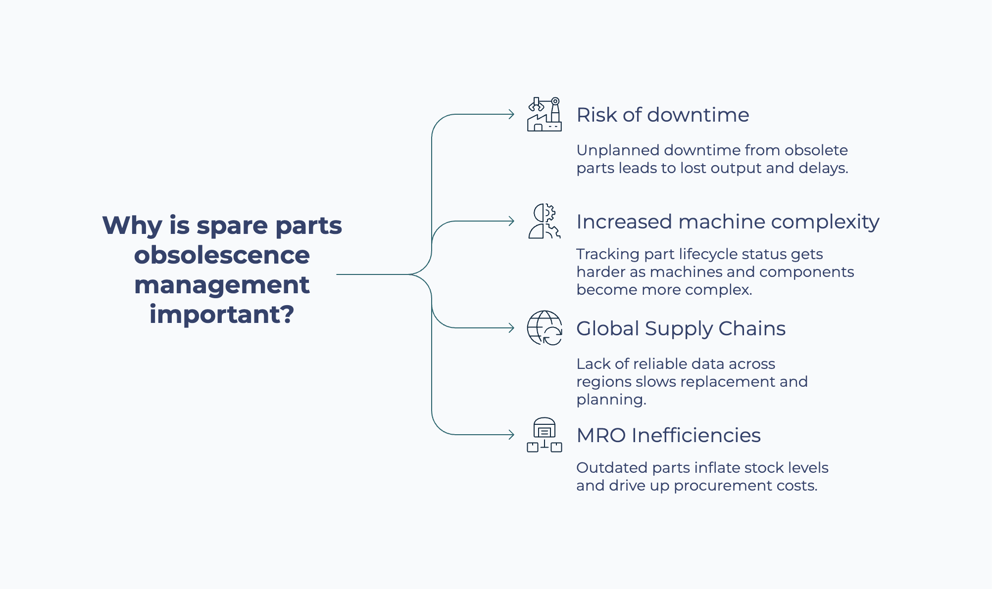Global Spare Parts Search
Stop searching, start finding
.png?width=300&name=BOM_Self_Service_Header%20(1).png)
Spare parts obsolescence management: How to handle discontinuations effectively
What is meant by Spare Parts Obsolescence?
Spare parts obsolescence refers to the situation where components or parts of a plant or system are no longer available or supported by the manufacturer, making it difficult to repair or maintain the operation of a production facility.
Discontinued spare parts can pose a threat to manufacturing operations because they are often no longer available. If the machine operator urgently needs a spare part due to a machine failure and it is not in stock, a lack of information about the spare part lifecycle status, obsolescence risk, and the successor product can lead to extended equipment downtime and costly production delays.
Spare Parts Obsolescence Management
Spare parts obsolescence management is a proactive approach to identifying and managing the risk of discontinued parts.
💡 Spare parts obsolescence management involves assessing the lifecycle status of components, monitoring manufacturer announcements about upcoming discontinuations, and ensuring that spare parts or successor components are available in time.
Machine operators can mitigate obsolescence risks by recognizing potential issues early and identifying equivalent spare parts, alternative suppliers, or proactive procurement strategies. This ensures that machines can continue to operate efficiently for many years, ultimately improving plant uptime and operational continuity.
In addition, companies that keep their spare parts data up to date can reduce the risk of unplanned downtime because critical parts are either already in stock or can be sourced with minimal delay.
Data Obsolescence
Data obsolescence occurs when product information (e.g., about spare parts) is no longer up to date. This negatively impacts the reliability of material master data, reduces data quality, and leads to less informed procurement and maintenance decisions.
Learn how SPARETECH can help through Master Data Insights.
Data obsolescence is particularly important in spare parts management because it can lead to errors in inventory management, procurement, and maintenance. If a spare part is obsolete, end-of-life, or no longer manufactured, relying on outdated material data can result in stock shortages, unplanned equipment downtime, and increased operational costs.
When does a spare part become obsolete or discontinued?
When a spare part reaches the end of its life cycle and is no longer manufactured, it is obsolete or discontinued. There are two main reasons for this:
- Technological progress: Technological progress can lead to certain spare parts becoming obsolete. For example, continuous progress in technologies for spare parts, but also in the manufacturing process, can lead to certain spare parts becoming obsolete and being replaced by newer, more efficient components. This is also accelerated by mergers and acquisitions, for example.
- Regulatory changes: Regulatory requirements may change over time, which may also result in certain spare parts being discontinued. For example, if a new regulation requires the use of a different type of material, the previously used spare parts may no longer be suitable.
Why is Spare Parts Obsolescence Management important in the manufacturing industry?

- Risk of downtime: In manufacturing, even short periods of unplanned downtime due to missing or obsolete spare parts can result in lost production, delayed deliveries, and reputational damage. Proactively managing spare parts obsolescence helps reduce this risk.
- Increased machine complexity: As industrial equipment becomes more sophisticated, the number of critical spare parts required for maintenance and repairs increases. This makes it harder for teams to monitor part lifecycle status and ensure that replacements are available when needed.
- Global supply chains: Relying on global supply chains for spare parts sourcing can make it difficult to access accurate and current obsolescence information. Variations in data quality between plants or regions can delay successor part identification and complicate inventory planning.
- Inventory and procurement inefficiencies: Without clear visibility into spare parts obsolescence and lifecycle status, companies often hold excess inventory of outdated components while scrambling to source discontinued or successor parts at the last minute—often at a premium. This reactive approach slows down procurement cycles, increases costs, and ties up capital in unused inventory.
Spare Parts Obsolescence Management today: Automation through software solutions
Ensuring up-to-date obsolescence information of spare parts can be a complex and costly task, especially when managing thousands of components across multiple systems and suppliers. The good news is that automation through software now enables a more scalable and proactive obsolescence management approach.
SPARETECH, a trusted MRO software, leverages the industry’s largest spare-parts catalogue, proprietary matching algorithms, and AI-enhanced recommendations to deliver valuable insights. By integrating real-time data on part discontinuations with our Data Lifecycle Management capabilities, we empower maintenance and procurement teams to identify successor parts early, mitigate risk before it impacts operations, and ensure uninterrupted equipment availability.
This means that obsolete or end-of-life components no longer catch teams off guard. Instead, they are flagged early—so critical spare part availability is maintained and costly downtime is avoided.
The SPARETECH solution integrates seamlessly with SAP AIN, S4 Hana and many other ERP systems.


-min.jpg?width=300&name=Resources_Menu%20(3)-min.jpg)
